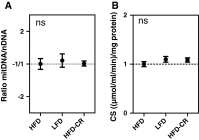Adipose tissue metabolism and inflammation are differently affected by weight loss in obese mice due to either a high-fat diet restriction or change to a low-fat diet
- PMID: 24718728
- PMCID: PMC4026436
- DOI: 10.1007/s12263-014-0391-9
Adipose tissue metabolism and inflammation are differently affected by weight loss in obese mice due to either a high-fat diet restriction or change to a low-fat diet
Abstract
Restriction of a high-fat diet (HFD) and a change to a low-fat diet (LFD) are two interventions that were shown to promote weight loss and improve parameters of metabolic health in obesity. Examination of the biochemical and molecular responses of white adipose tissue (WAT) to these interventions has not been performed so far. Here, male C57BL/6JOlaHsd mice, harboring an intact nicotinamide nucleotide transhydrogenase gene, were fed a purified 40 energy% HFD for 14 weeks to induce obesity. Afterward, mice were divided into three dietary groups: HFD (maintained on HFD), LFD (changed to LFD with identical ingredients), and HFD-CR (restricted to 70 % of the HFD). The effects of the interventions were examined after 5 weeks. Beneficial effects were seen for both HFD-CR and LFD (compared to HFD) regarding physiological parameters (body weight and fat mass) and metabolic parameters, including circulating insulin and leptin levels. Macrophage infiltration in WAT was reduced by both interventions, although more effectively by HFD-CR. Strikingly, molecular parameters in WAT differed between HFD-CR and LFD, with increased activation of mitochondrial carbohydrate and fat metabolism in HFD-CR mice. Our results confirm that restriction of the amount of dietary intake and reduction in the dietary energy content are both effective in inducing weight loss. The larger decrease in WAT inflammation and increase in mitochondrial carbohydrate metabolism may be due to a larger degree of energy restriction in HFD-CR, but could also be due to superior effectiveness of dietary restriction in weight loss strategies.
Figures







References
-
- Abete I, Astrup A, Martinez JA, Thorsdottir I, Zulet MA. Obesity and the metabolic syndrome: role of different dietary macronutrient distribution patterns and specific nutritional components on weight loss and maintenance. Nutr Rev. 2010;68:214–231. doi: 10.1111/j.1753-4887.2010.00280.x. - DOI - PubMed
-
- Burton BT, Foster WR, Hirsch J, Van Itallie TB. Health implications of obesity: an NIH consensus development conference. Int J Obes. 1985;9:155–170. - PubMed
-
- Chevalier L, Bos C, Azzout-Marniche D, Fromentin G, Mosoni L, Hafnaoui N, Piedcoq J, Tome D, Gaudichon C. Energy restriction only slightly influences protein metabolism in obese rats, whatever the level of protein and its source in the diet. Int J Obes (Lond) 2013;37:263–271. doi: 10.1038/ijo.2012.19. - DOI - PubMed
LinkOut - more resources
Full Text Sources
Other Literature Sources

